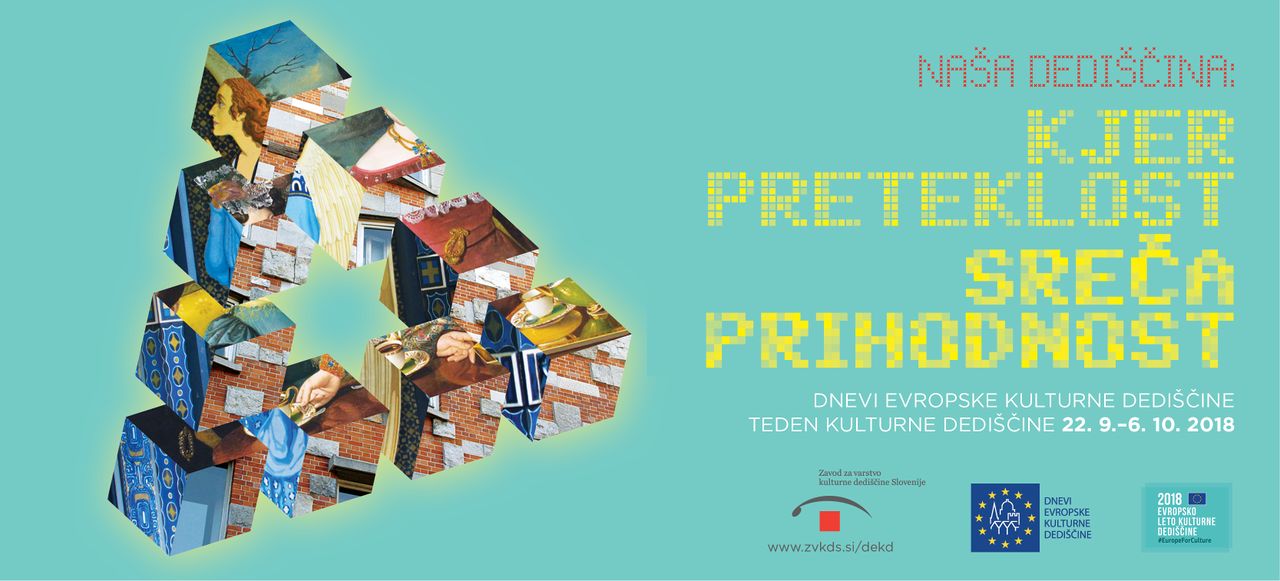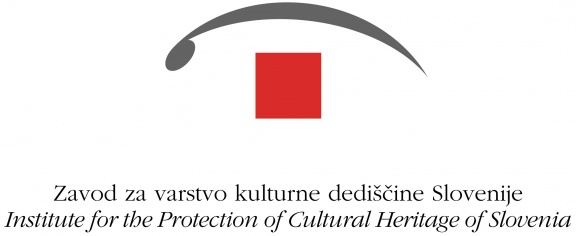Institute for the Protection of Cultural Heritage of Slovenia

-
to
11 Jan 2018
13 Jan 2018
AustriaSalzburgExhibition Center SalzburgThe Institute for the Protection of Cultural Heritage of Slovenia participates at the Monumento Salzburg fair
-
to
28 Jan 2016
30 Jan 2016
AustriaSalzburgExhibition Center SalzburgThe Institute for the Protection of Cultural Heritage of Slovenia participates at the Monumento Salzburg fair
-
to
10 May 2014
30 Nov 2014
BelgiumOudenaardeProvincial Heritage Center in EnameThe exhibition The Legacy of Charlemagne 814–2014 as a part of the international project Cradles of European Culture coordinated by the Institute for the Protection of Cultural Heritage of Slovenia, EU funded project,
History
The Slovenian territory, whether as part of the Austro-Hungarian Empire or the Socialist Republic of Yugoslavia, can trace its history of conservation offices concerned with maintaining and restoring the territory's many monuments and buildings of cultural heritage all the way to 1850. More details of this history are revealed in the historical overview article about Slovenian cultural heritage and conservation.
In 2008 the Slovene government passed a new law on cultural heritage thus reorganising the Institute for the Protection of Cultural Heritage of Slovenia as it is today.
Organisational structure
The IPCH comprises 2 main organisational units:
- The Cultural Heritage Service (Služba za kulturno dediščino) consists of 7 regional offices of the IPCH located in Celje, Kranj, Ljubljana, Maribor, Nova Gorica, Novo mesto, Piran. A regional office in Murska Sobota is also planned.
- The Conservation Centre (Center za konservatorstvo) comprises the Restoration Centre and the Centre for Preventive Archaeology.
Mission and tasks
The IPCH is active in the areas of conservation and restoration. It brings together art historians, archaeologists, architects, ethnologists, landscape architects, historians, sculptors, painters and many other experts who work in the institute's various organisational units. The goal of the institute is to preserve and protect the cultural heritage of Slovenia, to raise the broader public's interest in cultural heritage, as well as to achieve a balance of cultural monuments of the past with the existing natural and cultural environment and new architectural achievements.
The institute has a variety of administrative and professional duties related to the protection of both immovable cultural heritage and the associated movable and intangible cultural heritage. Its domain is not only the numerous procedures linked to the direct conservation of heritage and the prevention of damage, but also the large number of measures aimed at incorporating heritage into modern life, presenting heritage to the general public and developing awareness of its value.
The maintenance of cultural heritage and the guidelines for work on built heritage or on archaeological field examinations are the main tasks of the IPCH. Prior to work being carried out on cultural heritage a specification of the conditions and a cultural heritage agreement must be obtained from the competent regional office of the IPCH. On the other hand a preliminary archaeological research is managed and carried out by the Centre for Preventive Archaeology of the institute.
The IPCH distributes information on the tenders of the Ministry of Culture related to immovable heritage, calls for subsidies and loans available for renovation, as well as offers consulting and case studies.
Register
Experts of the IPCH and its corresponding regional offices are responsible for providing recommendations and data to the Heritage Information and Documentation Centre at the Ministry of Culture which maintains the online Register of Immovable Cultural Heritage. The register is an official, computer-supported database of immovable cultural heritage in Slovenia under the responsibility of the state. All units of immovable cultural heritage are entered into the register regardless of their type, size, ownership and whether or not they are legally protected.
Publications
The institute devotes a great deal of attention to the promotion of cultural heritage in the form of lectures, guided tours of monuments, exhibitions, online presentations, pamphlets and the Spomeniškovarstveni razgledi publications series, as well as other forms of promotion that have become established in contemporary heritage protection.
Since 1948 the publication Journal for the Protection of Monuments [Varstvo spomenikov] has been issued, which is the foremost scientific publication of the institute. Other serial publications are Cultural and Natural Monuments of Slovenia [Kulturni in naravni spomeniki Slovenije], which is a series of guidebooks, and a richly illustrated Series on Highway Archaeology [SAAS - Zbirka arheologija na avtocestah Slovenije], available in pdf format and online (in Slovenian). IPCH also publishes the DECH Series, annual anthologies related to the European Heritage Days [Zborniki DEKD], and the Vestnik Journal.
The Institute's e-Library is available online (see the links below).
International cooperation
Culthex is an important cross-border project (2009–2012) within the European territorial cooperation. Slovenian Gorenjska and Austrian Carinthia cooperate in the field of cultural heritage in order to establish a network of experts from different fields to help the owners of the heritage. The partners of the project include the Office of the Carinthian Government, Section 20, Planning, Klagenfurt; the Business Support Centre (BSC) Ltd, Kranj, and the municipalities of Bled, Radovljica, Tržič, and Gorenja vas–Poljane.
IPCH is also involved in the CARARE, PArSJAD, CEC, REVITAS, Shared Culture, Pearls of our Cultural Landscape [Biseri naše kulturne krajine], and TrArS (Tracing the Art of the Straub Family) international projects.
In 2009 the Institute for the Protection of Cultural Heritage signed a bilateral agreement on cooperation with the Smithsonian Institution, the largest institution in the cultural field in the USA as well as the largest museum complex and conservation centre in the world. The cooperation is focused on sharing common interests and knowledge and training new specialists.
Among the partners in the international cooperative project Identification of Wood and Dendrocronology are also the Metropolitan Museum of New York and the Smithsonian Institution.
In 2006 the institute also took part in the international project European Bridge for Sarajevo, which aimed at founding a Restoration Centre at the Academy of Fine Arts in Sarajevo.
European Heritage Days
In 1991 Slovenia, along with a number of other European countries and the Council of Europe, was one of the founders and initiators of the "Days of European Cultural Heritage" or "DECH" [Dnevi evropske kulturne dediščine (DEKD)]. Every September a series of events are organised in Slovenia. The DECH Series published by the IPCH includes 16 bilingual publications, among them Historical Parks and Gardens in Slovenia (1995), The Heritage of Monastic Order (1996), Art Nouveau Architecture in Slovenia (1998), Medieval Towns in Slovenia (1998), 20th Century: Slovene Architecture from Modernism to Contemporaneity (2001), Castles, Fortresses and City Walls (2006), and the most recent programmes dedicated to the architect Jože Plečnik (2007), and the father of written Slovenian language Primož Trubar (2008). The programme in 2009 was dedicated to the "Heritage, Creativity and Innovation", in 2010 to "Cultural Heritage and Prosperity", both followed by pan-European campaigns. In 2011 the common theme was Heritage Communities and Volunteering and in 2012 (the Year for Active Ageing and Solidarity between Generations) The Experience of Heritage. In 2013 the EHD was conceived under the motto A century of benefiting heritage, related to a centenary of the appointment of art historian France Stele to the position of the provincial conservationist of the Monument Office for Carniola in 1913.
With these events, the IPCH has been particularly successful in enhancing the image of cultural heritage promotion in Europe.
 Days of European Cultural Heritage 2018 banner
Days of European Cultural Heritage 2018 banner
See also
- European Year of Cultural Heritage 2018
- Heritage preservation and restoration in Slovenia (overview article)
- Heritage Information and Documentation Centre, Ministry of Culture
Regional offices
- Celje Regional Office
- Kranj Regional Office
- Ljubljana Regional Office
- Maribor Regional Office
- Nova Gorica Regional Office
- Novo mesto Regional Office
- Piran Regional Office
Conservation Centre
Other related links
- Association of Conservators of Cultural Heritage of Slovenia
- Stele Award
- Register of Slovene cultural heritage - rkd.situla.org
- Slovene Association of Historic Towns
External links
International projects
- Support services
- Museums
- Tourism
- Publishers
- Exhibition organisers
- Event organisers
- EU funding of Slovene organisations (Culture and MEDIA Programmes)
- EU Culture funding recipient
- National cultural institutions
- Underwater cultural heritage
- Architecture archives & libraries
- Heritage organisations
- Cultural heritage education and research
- Museum funding, professional and support services
- Education and Research
- Funding, professional and support services




